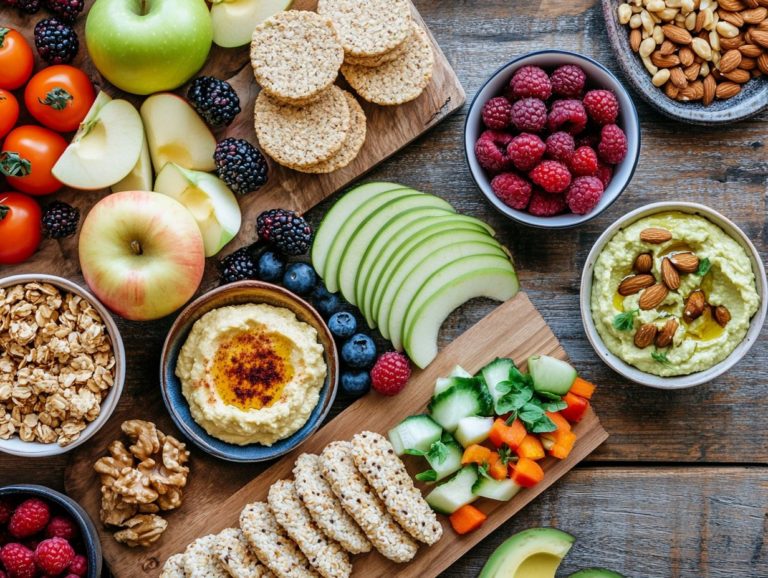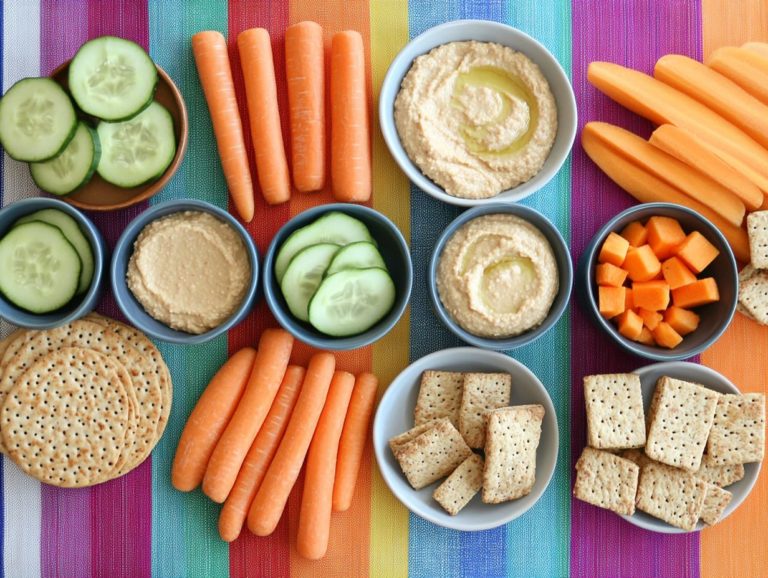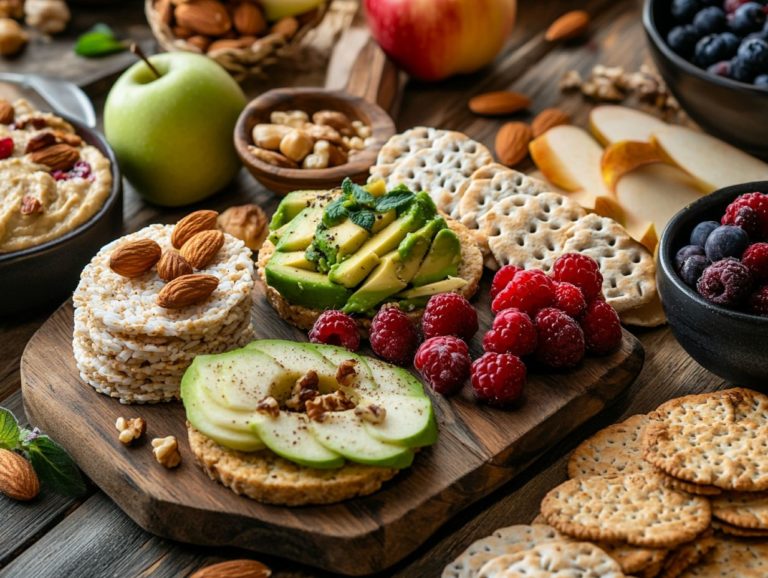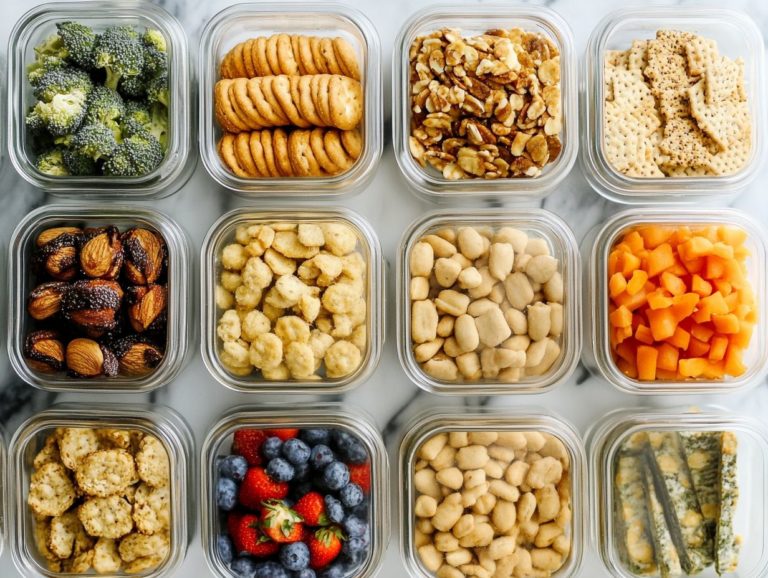Which Grains Are Gluten-Free?
Navigating a gluten-free diet presents its own set of challenges, particularly when it comes to selecting the right grains, such as quinoa and millet.
Whether you re managing celiac disease or simply exploring a gluten-free lifestyle, having a solid understanding of your options is crucial. This article, featuring insights from experts like Elizabeth Pratt and Kumkum S. Patel, MD, delves into a range of gluten-free grains, spotlighting popular choices like rice and quinoa while emphasizing their unique benefits.
Discover how to seamlessly incorporate these nutritious alternatives into your meals, allowing you to savor delightful flavors without compromising your health. Organizations like the Celiac Disease Foundation and research from Harvard T.H. Chan School of Public Health offer valuable guidance on maintaining a balanced gluten-free diet.
Contents
Key Takeaways:
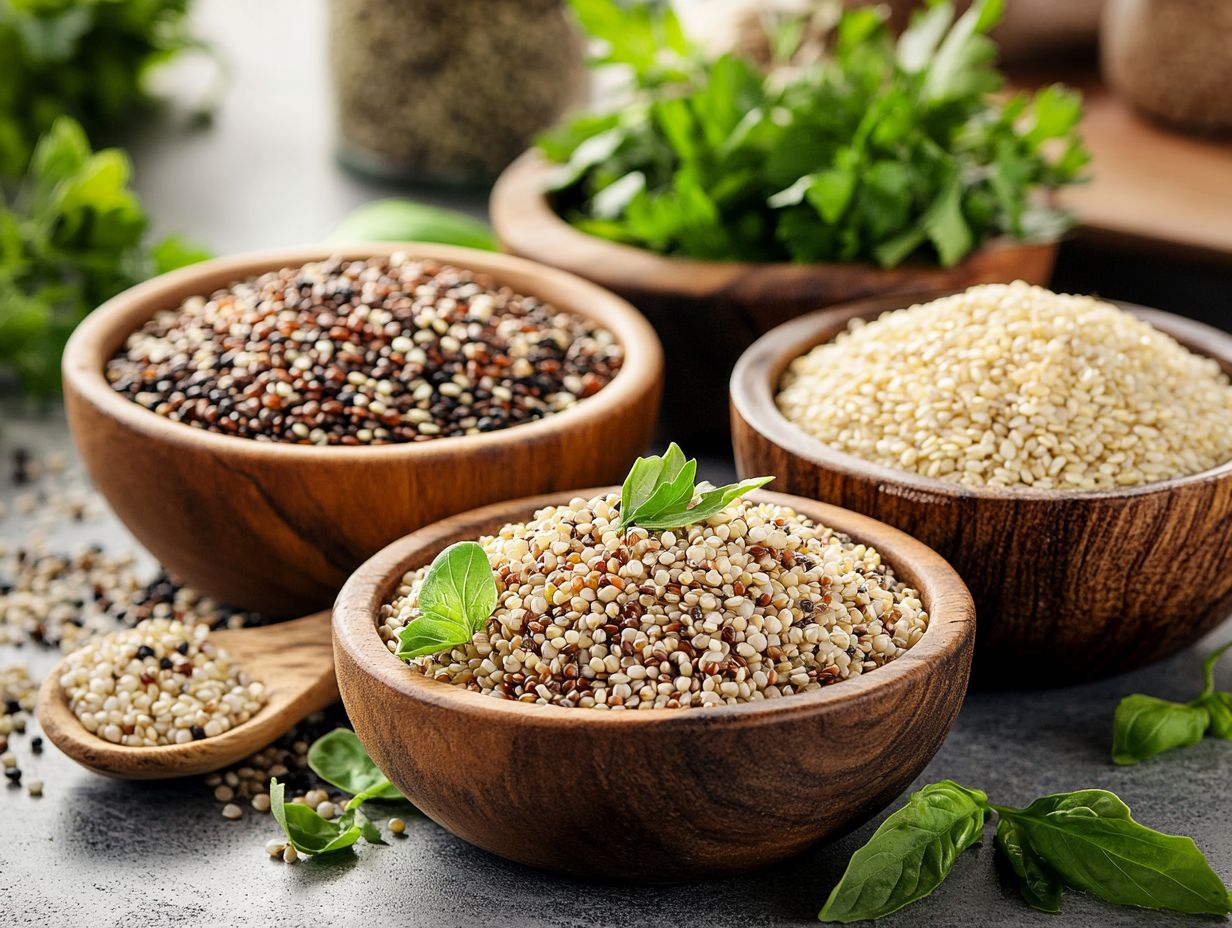
- Gluten-free grains include rice, corn, quinoa, oats, millet, sorghum, buckwheat, amaranth, teff, and wild rice.
- A gluten-free diet can help with celiac disease, reduce inflammation, improve digestive health, and aid in weight loss.
- Incorporate gluten-free grains into your diet by swapping out wheat-based products, experimenting with new recipes, trying alternative flour blends like teff flour, and exploring new millet recipes.
What Are Gluten-Free Grains?
Gluten-free grains are essential to a gluten-free diet, particularly for those navigating the challenges of celiac disease or gluten intolerance. These wholesome grains not only deliver a delightful array of flavors and textures but also pack a wealth of health benefits that enhance digestive health and overall well-being, as emphasized by experts from Johns Hopkins Medicine.
Popular Gluten-Free Grains
Among the most popular gluten-free options are:
- quinoa – Known for its impressive nutritional profile and antioxidants.
- oats – Recognized for its benefits, especially its beta-glucan content.
- brown rice – A gluten-free staple with high fiber content.
- corn – Valued for its nutritional benefits.
- millet – A versatile grain featured in numerous millet recipes.
- amaranth – Praised for its high protein content.
- teff – Often used in teff flour for baking.
- buckwheat – Known for its health benefits.
Each of these grains boasts a unique nutritional profile, making them perfect for a variety of recipes while supporting a balanced gluten-free diet. Understanding how these grains can benefit you is essential for anyone eager to elevate their health or manage gluten-related challenges, including those related to celiac disease and gluten intolerance.
1. Rice
Rice, especially brown rice, is among the most popular gluten-free grains you can enjoy, offering a wealth of nutritional benefits and fiber that supports your digestive health. According to the Celiac Disease Foundation, brown rice is an important part of a balanced gluten-free diet.
This whole grain shines with its impressive fiber content. It not only promotes digestion but also helps you feel full, making it a superb choice if you’re looking to manage your weight.
Brown rice is incredibly versatile in the kitchen; you can easily incorporate it into a wide variety of dishes, from stir-fries and salads to hearty soups and pilafs. It effortlessly adapts to different cuisines, guidance also echoed by research from the Harvard T.H. Chan School of Public Health.
For those of you with gluten sensitivities, it s essential to ensure that your brown rice remains uncontaminated by gluten-containing grains during processing or cooking. After all, avoiding cross-contamination is key to truly enjoying the benefits of your gluten-free choices.
Always opt for gluten-free certified products to minimize the risk of cross-contamination.
Conclusion
Integrating gluten-free grains into your diet can transform your meals while enhancing your health. Start experimenting with these grains today for a healthier lifestyle!
Discover the Benefits of Gluten-Free Grains
Looking for delicious ways to enhance your meals? Try these grains!
2. Corn
Corn stands out as a remarkable gluten-free grain, packed with nutritional benefits that make it a cornerstone of many gluten-free diets and recipes. According to experts like Elizabeth Pratt, corn is rich in fiber, B vitamins, and antioxidants.
Its versatility shines through in various forms, such as cornmeal, which is a key ingredient for making delightful cornbread and polenta. Both cornmeal and polenta serve as excellent alternatives for those steering clear of gluten, offering a pleasing texture and essential nutrients.
By incorporating these corn-based products into your meals, you’ll boost your digestive health right away! Embracing corn in gluten-free cooking opens up a world of delicious possibilities, from savory to sweet, ensuring that you can still savor your favorite dishes.
3. Quinoa
Quinoa deserves its accolades for being a nutritious food, rich in protein and antioxidants, making it an ideal choice among gluten-free grains. Its profile includes all nine essential amino acids, making it a complete protein source.
This ancient grain offers heart-healthy fats along with a multitude of vitamins and minerals. Preparing quinoa is simple; you can boil, steam, or toss it into salads, soups, and bowls. Its mild, nutty flavor pairs beautifully with a variety of vegetables, spices, and sauces.
Whether you’re crafting warm quinoa pilafs with roasted vegetables or refreshing quinoa salads drizzled with citrus vinaigrette and fresh herbs, the possibilities are endless. This superfood will effortlessly elevate your daily meals!
4. Oats
Oats are a remarkable gluten-free grain choice, especially when you opt for certified gluten-free varieties to avoid cross-contamination. Their rich content of beta-glucan, a soluble fiber, is particularly noteworthy for its health benefits.
Oats provide a rich source of essential nutrients, helping to lower cholesterol, enhance heart health, and regulate blood sugar. This makes oats an outstanding option for anyone looking to improve their nutrition.
When choosing oats, select those labeled as gluten-free certified; this ensures they haven’t come into contact with gluten-containing grains. Incorporating oats into your daily meals is simple and incredibly tasty imagine overnight oats or hearty oatmeal bowls adorned with fresh fruits!
5. Millet
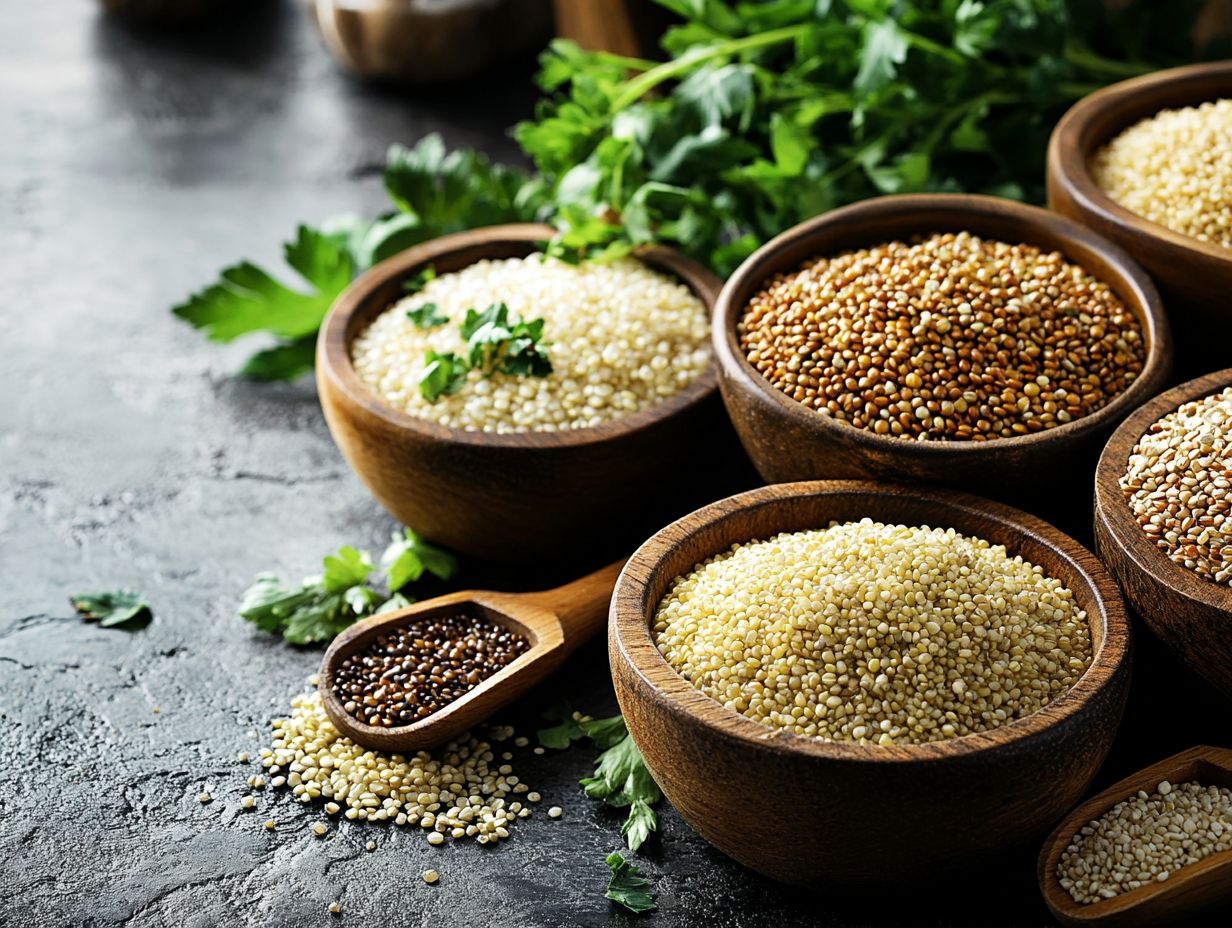
Millet is a hidden gem among gluten-free grains, offering unique nutritional benefits and the potential to elevate your culinary creations. Packed with protein, fiber, and essential vitamins and minerals, millet isn t just healthy; it s also versatile.
You can use it as a base for salads, whip up a comforting porridge, or serve it as a delightful side dish. This makes millet a superb alternative to traditional grains.
Preparing millet is straightforward. Simply cook it in water or broth, much like rice. Once it s done, you ll find it has a light, fluffy texture that absorbs flavors from herbs and spices, inviting your creativity.
Whether baking gluten-free bread or crafting a savory stir-fry, adding millet to your meals enhances your culinary experience while giving your nutrition a healthy boost.
Conclusion
Incorporating these gluten-free grains into your diet not only enhances your meals but also provides a wealth of nutritional benefits. Discover new recipes and enjoy the flavors they bring!
6. Sorghum
Sorghum is a gluten-free grain that s steadily gaining traction for its impressive nutritional profile and versatility in the kitchen. Its benefits are highlighted by experts like Kumkum S. Patel, MD, emphasizing its role in a balanced diet.
Packed with high fiber content, essential minerals, and antioxidants, this remarkable grain offers a plethora of health benefits, making it an outstanding choice for anyone seeking to uphold a balanced diet. In your culinary adventures, you can transform sorghum into an array of dishes, from savory salads and hearty stews to delightful baked treats like muffins and pancakes. Its distinct flavor and texture position it as an excellent alternative to wheat in many recipes, particularly for those with gluten sensitivities.
Cooking sorghum is easy; you can boil, simmer, or even pop it, allowing for endless creativity in your meals. Whether you re aiming to impress guests or simply enjoy a nutritious dinner, sorghum will elevate your cooking game to new heights!
7. Buckwheat
Buckwheat is a highly nutritious gluten-free grain that offers a wealth of health benefits, notably its richness in fiber and antioxidants. This remarkable grain not only promotes heart health by lowering cholesterol levels but also helps regulate blood sugar, making it an excellent choice for anyone managing diabetes. Its health benefits make it a standout in gluten-free diets.
With its impressive protein content, buckwheat stands out as a satisfying alternative for vegans and vegetarians alike. Its culinary versatility opens the door to a myriad of delicious preparations, from wholesome pancakes and savory noodles to hearty salads.
Integrating buckwheat into your gluten-free diet is a breeze; it can easily replace traditional grains in countless recipes, all while providing both nourishment and delightful flavor. Whether you savor it as a warm porridge or toast it for a delightful crunch on top of your dishes, buckwheat enhances your meals while delivering essential nutrients.
8. Amaranth
Amaranth is a remarkable gluten-free grain that truly shines with its impressive protein content and wealth of vitamins and minerals. Amaranth protein is particularly noted for its high quality, making it an excellent addition to any diet.
This ancient grain is not just a smart choice for those sensitive to gluten; it also offers a generous supply of fiber, iron, and magnesium, making it an excellent addition to anyone’s diet. You’ll appreciate its pleasantly nutty flavor, as it can be prepared much like rice or quinoa simply simmer it in water or broth until it reaches the perfect tenderness. According to the Celiac Disease Foundation, incorporating amaranth into a gluten-free diet can significantly enhance your nutrient intake.
Its versatility allows it to star in a variety of delicious recipes, including:
- Amaranth porridge, beautifully topped with fresh fruits and nuts
- Leafy green salads, where amaranth serves as a delightful protein source paired with a variety of vegetables
- Baked goods like energy bars that are both nutritious and satisfying, providing a healthy boost
These options highlight its nutritional benefits while appealing to a diverse range of taste preferences. Try adding amaranth to your next meal for a nutrient-packed boost!
9. Teff
Teff, often found in its teff flour form, is a tiny gluten-free grain brimming with nutrition and serves as a staple in the diets of many cultures, especially in Ethiopian cuisine.
This ancient grain is not only abundant in protein but also offers an impressive array of vitamins and minerals, including calcium, iron, and fiber content. You might find teff a delightful addition to your diet due to its versatility; it can be transformed into a variety of dishes, but it truly shines in the creation of injera (a traditional Ethiopian flatbread), which serves as a handy tool for scooping up flavorful stews, making it an essential component of communal meals.
For those seeking gluten-free options, teff stands out as a nourishing alternative that fits seamlessly into various recipes, from pancakes to porridge, enabling you to maintain a balanced and health-conscious lifestyle. Consider trying teff in your next recipe for a delicious and nutritious addition!
Wild Rice and Gluten-Free Diet Benefits
10. Wild Rice
Wild rice, which is technically a water grass rather than true rice, is a gluten-free grain that brings unique flavors and impressive nutritional benefits to your table.
With its rich, nutty flavor, wild rice complements a wide range of dishes, making it a versatile staple in kitchens across the globe. It is often compared with other gluten-free grains like quinoa, oats, corn, millet, amaranth, teff, and buckwheat for its nutritional value.
Packed with protein, fiber, and essential vitamins, this grain is an excellent choice for anyone aiming to enhance their diet. You ll find countless culinary applications for wild rice; it shines in salads, soups, or as a side dish, adding both depth and texture to your meals.
If you want to create exciting gluten-free dishes, incorporating wild rice into your recipes can offer not just a hearty addition but also an intriguing twist that transforms ordinary grain dishes into something truly exceptional.
What Are the Benefits of a Gluten-Free Diet?
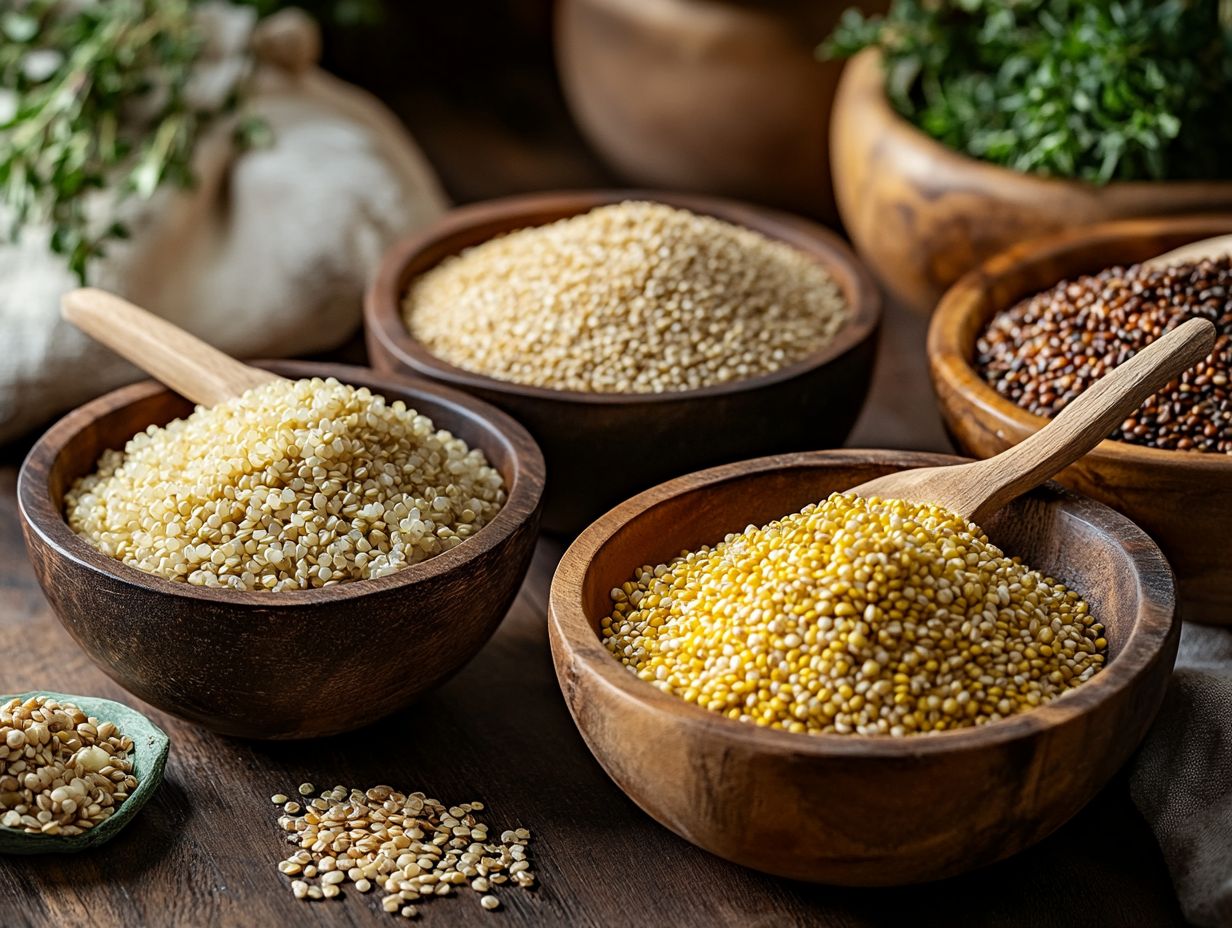
A gluten-free diet can provide a wealth of benefits, especially for those dealing with celiac disease or gluten intolerance. Research from the Celiac Disease Foundation and Harvard T.H. Chan School of Public Health supports these benefits. By significantly reducing inflammation, it can greatly enhance your digestive health.
When you eliminate gluten-containing foods from your meals, you may find relief from the discomfort associated with gluten sensitivity, ultimately boosting your overall well-being. According to Johns Hopkins Medicine, such dietary changes can have profound impacts.
Embracing this dietary shift can lead to a more vibrant, healthier you.
1. Helps with Celiac Disease
For those navigating life with celiac disease, adhering to a gluten-free diet isn’t just a choice; it s a vital necessity for maintaining health and avoiding severe reactions.
This necessity stems from your body s negative reaction to gluten a protein lurking in wheat, barley, and rye which can unleash a host of uncomfortable and sometimes debilitating symptoms, including those outlined by Dr. Kumkum S. Patel, MD.
You might experience digestive woes like bloating, diarrhea, and abdominal pain, alongside systemic issues such as fatigue, skin rashes, and nutritional deficiencies.
To successfully manage this condition, you ll need to become a savvy label reader, meticulously choosing gluten-free certified foods and watching for potential cross-contamination.
By doing so, you not only enhance your quality of life but also safeguard your intestines from the damage that gluten can cause.
2. Reduces Inflammation
One of the remarkable advantages of adopting a gluten-free diet is its potential to significantly reduce inflammation within your body, particularly if you are gluten intolerant. Studies have shown that eliminating gluten can also positively impact digestive health.
This reduction in inflammation can lead to notable improvements in a variety of health concerns, such as joint pain, digestive disorders, and even certain skin conditions.
The underlying science explains that gluten can provoke an immune response, resulting in chronic inflammation that negatively impacts your overall well-being. By eliminating gluten from your diet, you may find a decrease in inflammatory markers, thereby enhancing your body’s natural healing capabilities.
Embracing an anti-inflammatory diet that emphasizes whole, unprocessed foods can further amplify these benefits, facilitating not only a reduction in inflammation but also encouraging long-term health improvements.
Start exploring gluten-free recipes today for a healthier lifestyle!
3. May Improve Digestive Health
A gluten-free diet has the potential to enhance your digestive health by eliminating irritants and incorporating fiber-rich gluten-free grains. This dietary shift can significantly reduce inflammation and discomfort often triggered by gluten-containing foods.
By focusing on gluten-free grains such as quinoa, brown rice, and millet, you provide your body with essential nutrients that enhance digestive function. These grains are not just fiber powerhouses vital for regular bowel movements and overall gut health but they also offer beneficial vitamins and minerals that support your well-being.
For instance, quinoa is known for its antioxidants, and amaranth is celebrated for its high protein content. Fiber plays a crucial role in nourishing the good bacteria in your gut, promoting a balanced microbiome that is essential for optimal digestion and immune health.
How to Incorporate Gluten-Free Grains into Your Diet?
Incorporating gluten-free grains into your diet can be an effortless and delightful journey, opening the door to a myriad of culinary experiences tailored to your gluten-free needs. By substituting traditional wheat-based products with gluten-free alternatives, you elevate the diversity of your meals and enrich your nutritional profile with these wholesome grains.
1. Swap Out Wheat-Based Products
One effective approach to incorporating gluten-free grains into your diet is to replace wheat-based products with gluten-free alternatives like almond flour, buckwheat, or quinoa.
These options serve as safe choices for those with celiac disease or gluten intolerance while enhancing the nutritional quality of your meals. Buckwheat, for example, is celebrated for its health benefits, including high fiber and essential amino acids.
Almond flour is an excellent source of healthy fats and protein, making it perfect for baking delectable treats that require a moist texture. Meanwhile, buckwheat, despite its name, is actually a seed packed with fiber and essential amino acids.
Quinoa takes the spotlight as a complete protein, providing all nine essential amino acids, which is especially advantageous for vegetarians or anyone aiming to increase their protein intake.
By exploring these substitutions, you can savor a diverse array of foods while prioritizing your health.
2. Experiment with New Recipes
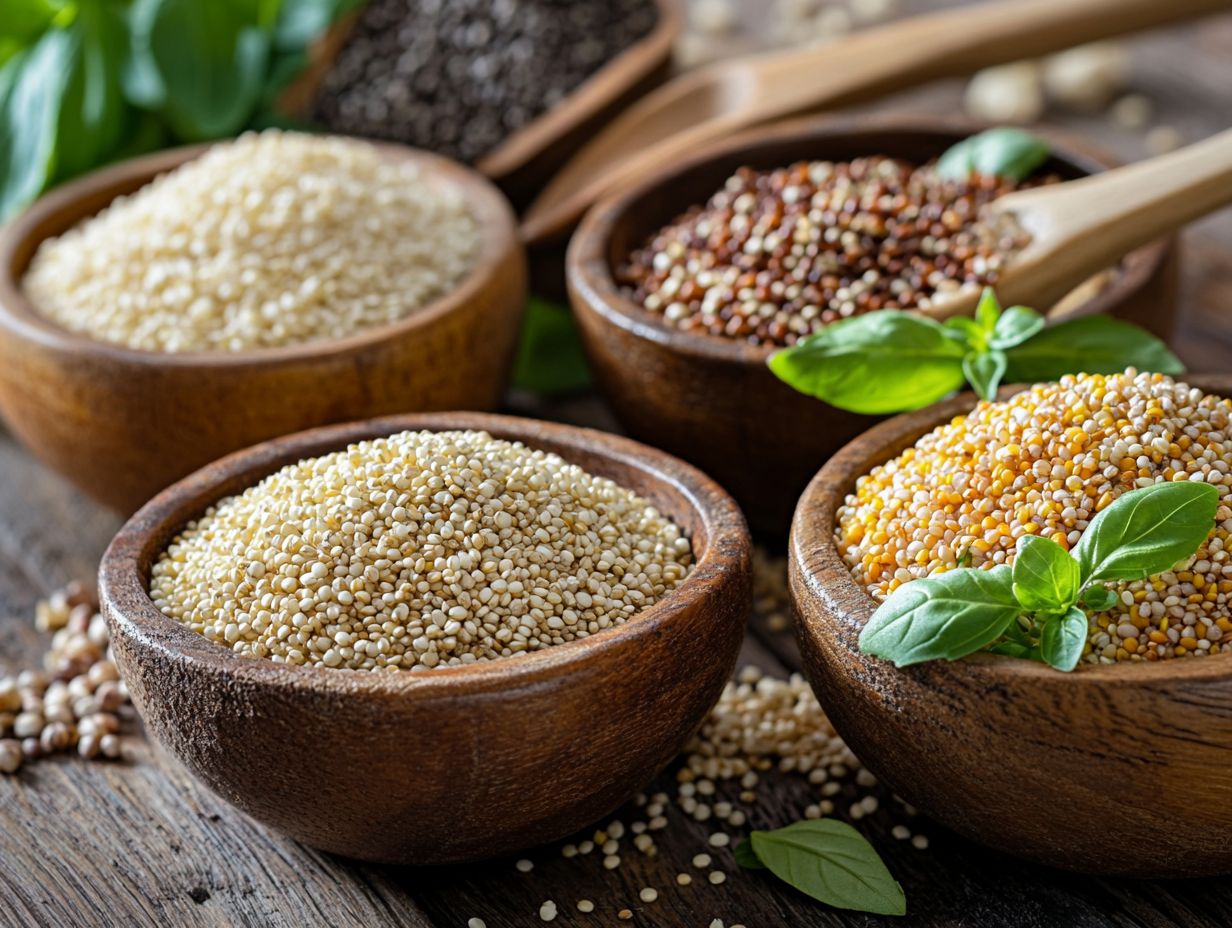
Experimenting with new recipes elevates your meals and tantalizes your taste buds. By exploring options like quinoa, millet, and amaranth, you unlock a world of flavors and textures that can transform your everyday dishes into culinary masterpieces.
Each grain possesses its own distinct characteristics; for instance, quinoa brings a nutty flavor and a delightful crunch, while millet offers a subtly sweet profile that works beautifully in both savory and sweet dishes.
Allow your creativity to flourish in the kitchen by whipping up a hearty quinoa salad or perhaps a warm millet porridge to kickstart your day with a nutritious boost. The versatility of these grains accommodates diverse dietary preferences and invites a sense of adventure, making mealtime an experience to eagerly anticipate.
3. Try Alternative Flour Blends
Exploring alternative flour blends made from gluten-free grains can elevate your baking and cooking, enabling you to create delightful dishes without sacrificing flavor.
These unique flours not only accommodate those with diet needs but also bring an exciting variety of flavors and textures to your cherished recipes. For example, when you combine almond flour with coconut flour, you achieve a delightful nutty sweetness and moisture. Similarly, a mixture of oat flour and chickpea flour introduces a wholesome, hearty quality to your meals.
To incorporate these alternative blends, simply substitute them in equal parts for traditional wheat flour in your favorite recipes like pancakes, cookies, and bread. For instance, using a mix of oat flour and chickpea flour can add both fiber and protein to your dishes.
By experimenting with different combinations, you unlock a world of culinary possibilities, allowing you to add a personal touch to each dish while enhancing its nutritional value.
Frequently Asked Questions
Summary: Incorporating gluten-free grains into your diet can improve digestive health and overall well-being. By swapping out wheat-based products, experimenting with new recipes, and trying alternative flour blends, you can enjoy a variety of flavors and health benefits. Remember to explore different grains like quinoa, millet, and buckwheat to enhance your meals!
Which Grains Are Gluten-Free?
The following grains are naturally gluten-free:
- Rice
- Corn
- Sorghum
- Quinoa
- Millet
- Buckwheat
- Amaranth
Can I Eat Oats If I Am Gluten-Intolerant?
Yes, oats are technically gluten-free. However, they are often contaminated with gluten during processing. Look for certified gluten-free oats if you want to include them in your diet.
Are All Types of Wheat Considered Gluten-Free?
No, all types of wheat contain gluten. This includes popular varieties like durum, spelt, and semolina. For those with gluten intolerance, it is essential to avoid these grains.
What About Barley and Rye?
Barley and rye both contain gluten and should be avoided by those following a gluten-free diet. Additionally, be cautious of beta-glucan in oats, which may be beneficial, but requires gluten-free certification to avoid cross-contamination.
Are There Any Grains That May Contain Hidden Gluten?
Yes, some grains may be cross-contaminated with gluten during processing. These include farro, bulgur, and couscous. Always check the label or contact the manufacturer to ensure they are gluten-free.
Can I Still Have Grains in My Diet If I Have Gluten Intolerance or Celiac Disease?
Absolutely! There are plenty of gluten-free grains to choose from that offer similar nutritional benefits. For instance, quinoa is well-known for its high fiber and antioxidant content, while oats can provide a good source of beta-glucan. Experiment with different options like brown rice, corn, millet, amaranth, teff, and buckwheat. Consider their nutritional values such as protein, fiber, and antioxidants. Make sure to look for gluten-free certified foods to avoid cross-contamination and maintain your digestive health.


